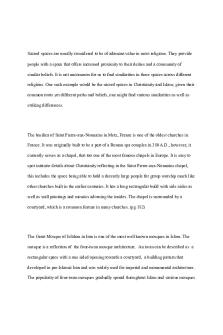Understanding Transition Spaces PDF

| Title | Understanding Transition Spaces |
|---|---|
| Author | Rashmi Singh |
| Pages | 33 |
| File Size | 1.4 MB |
| File Type | |
| Total Downloads | 159 |
| Total Views | 604 |
Summary
Understanding Transition Spaces Importance and Role in Indian Architecture Rashmi Singh B.Arch., SSAA (12000099) Dissertation | UNDERSTANDING TRANSITION SPACES | 2015 ACKNOWLEDGEMENTS This dissertation would not have been successful without the support and encouragement of many people. I would like ...
Description
Understanding Transition Spaces Importance and Role in Indian Architecture Rashmi Singh
B.Arch., SSAA (12000099)
Dissertation | UNDERSTANDING TRANSITION SPACES | 2015
ACKNOWLEDGEMENTS This dissertation would not have been successful without the support and encouragement of many people.
I would like to take this opportunity to express my sincere gratitude and deep regard to my guide, Ar. Vandini Mehta, for her exemplary guidance, valuable feedback and constant encouragement throughout the duration of the dissertation. Her perceptive critiques kept me working to make this dissertation better. Working under her was an extremely knowledgeable experience for me. Besides my guide, I would like to thank my mentor, Ar. Thomas Oommen, for his insightful comments and assistance during the initial, decisive stages of the research that helped me frame and direct my dissertation. His valuable suggestions were of immense help. I would also like to thank our dissertation coordinators, without whose hard work the dissertation would not have been successfully complete. The time table and the reminders helped me immensely, in managing my time along with the other subjects. Lastly, I would like to thank my family for their moral support and encouragement throughout the semester.
Page 2 of 33
Dissertation | UNDERSTANDING TRANSITION SPACES | 2015
CONTENTS ACKNOWLEDGEMENTS ............................................................................................................................................ 2 CONTENTS .................................................................................................................................................................... 3 List of Figures ................................................................................................................................................................ 4 Chapter 1: ABSTRACT ................................................................................................................................................ 5 Chapter 2: INTRODUCTION ...................................................................................................................................... 7
What is a Transition Space? ....................................................................................................................... 7
Hierarchy ........................................................................................................................................................ 9
Transition Spaces in Indian context ........................................................................................................... 9
Chapter 3: TRANSITION SPACES IN SPACE AND TIME ................................................................................... 11
Variation with building type or scale in India ..................................................................................... 13
Chapter 4: TRANSITION SPACES IN INDIAN ARCHITECTURE ......................................................................... 16
Courtyard as a Transition Space in Indian context............................................................................. 16
Entrance or Threshold as a Transition space ........................................................................................ 18
Chapter 3: CASE STUDIES ...................................................................................................................................... 19
ARCHITECT: B. V. DOSHI .......................................................................................................................... 19 Philosophies and Ideologies .................................................................................................................... 19 Analysis of Projects ................................................................................................................................... 20
ARCHITECT: CHARLES CORREA .............................................................................................................. 26 Philosophies and Ideologies ..................................................................................................................... 26 Analysis of Projects..................................................................................................................................... 26
Chapter 5: CONCLUSION ...................................................................................................................................... 31 BIBLIOGRAPHY ......................................................................................................................................................... 32
Page 3 of 33
Dissertation | UNDERSTANDING TRANSITION SPACES | 2015
List of Figures Figure 1: Diagram explaining the relationship between public- private and open- closed transition spaces. .......................................................................................................................................................................... 7 Figure 2: Anup Talao, Fatehpur Sikri, with the platform in the centre. .......................................................... 10 Figure 3: Threshold of a haveli.
Figure 4: The courtyard inside a haveli. ............. 13
Figure 5: Plan of the Ranganathaswamy Temple, Srirangam. ........................................................................ 14 Figure 6: The interior courtyard of nalukettu. ..................................................................................................... 16 Figure 7: Courtyard like spaces in between houses/ havelis in Jaisalmer.................................................... 17 Figure 8: Entrance at the Buland Darwaza, Fatehpur Sikri.............................................................................. 18 Figure 9: The image shows the cluster of houses in the Aranya Township. .................................................. 21 Figure 10: The image shows the basic layout of the Aranya housing development. ................................ 21 Figure 11: Characters of Otla. .............................................................................................................................. 22 Figure 12: The different types and level of activities in the otla. .................................................................. 22 Figure 13: An otla without any boundary.
Figure 14: An otla with a boundary wall. ... 22
Figure 15: House in Aranya Development showing different otlas................................................................ 23 Figure 16: The front façade of Institute of Indology. ...................................................................................... 24 Figure 17: Plan of Institute of Indology................................................................................................................ 25 Figure 18: The garden and the entrance.
Figure 19: The paved courtyard. ................ 25
Figure 20: Plan of the Belapur Housing. .............................................................................................................. 27 Figure 21: Relation b/w single units
Figure 22: Small Courtyard town ................ 27
Figure 23: Formation of the plan from a single unit to the settlement. .......................................................... 28 Figure 24: Private transition space. ...................................................................................................................... 28 Figure 25: Small Courtyard town serving 6-8 houses. ...................................................................................... 28 Figure 26: Community Park at a development level. ........................................................................................ 29 Figure 27: Landscape of Bharat Bhavan. ............................................................................................................ 29 Figure 28: The different courtyards in the premise. ......................................................................................... 30 Figure 29: The galleries of Bharat Bhavan. ....................................................................................................... 30
Page 4 of 33
Dissertation | UNDERSTANDING TRANSITION SPACES | 2015
Chapter 1: ABSTRACT “Architectural spaces that envelop us like a physical presence, simple and dense, defying description imitation and photography. . . . universal, yet present. The exterior is simple leading to greater levels of mystery surprise and memory, creating poetic changes of light and shade . . . guiding us through its spaces . . . .” - Alvaro Siza on Mexican Architecture (Deshmukh, 2009)
Transition – an in between state, in Architecture, is defined as a link or a connecting space between two enclosed spaces. An architectural space is incomplete without transition spaces. The inclusion of transitional and circulation spaces, in the form of corridors, atriums and stairwells, is unavoidable in the design of most buildings. The percentage of these spaces may however vary according to the function/ type of the building. Their functionality also varies according to the appropriate requirements of the building or the user.1 These in between spaces offer an opportunity to interfere and create a space which re-engages the person, in that space or passing through that space, through repetitive interruptions or pauses. The transitional spaces can be planned or can be a left over space, but both these types of spaces are in a continuous state of flux resulting into a “transition place”. The spaces could create subtle interconnections which can be exploited and temporal experiences could be defined through architectural interpretation of transitional spaces. Looking at Indian architecture, there are features like pavilions, courtyards, terraces, and thresholds which accentuate transition. All of these features come together to articulate the space. The elements can be used in buildings of many typology or function, such as, temple, palaces, ghats, residence, institutional buildings, etc. The listed features might show anonymity in their existence but their true meaning emerges from the context and its use. We will look at the use of these features, in detail, later in the dissertation.
We transit so often that we are not even conscious of that space being there. It is very interesting to know about it. We experience them from macro to micro levels, while being completely unaware of its presence. Therefore, in order to understand transition spaces, I would like to do an in depth study of how such spaces came up, their evolution, hierarchy and to analyse their role and importance. The
1
(Deshmukh, 2009) Page 5 of 33
Dissertation | UNDERSTANDING TRANSITION SPACES | 2015
evaluation of the works and philosophies of architects working with transition spaces will further help in understanding such spaces in Indian context. The dissertation examines the various transitional spaces used in Indian Architecture by investigating the works of architects like B. V. Doshi and Charles Correa. The aim will also be to derive how these transition spaces have lend Indian-ness to buildings, their different typologies and variation according to the function of the building. The dissertation will include case studies of the philosophies and various projects of these architects. My research will also include a formal analysis of the works, which will be covering a housing project and an individual house/ building. I have chosen these particular architects as both of them try to identify Indian identity and introduce it in their projects. Through their projects I will be able to understand the various transition spaces that they have integrated and it will allow me to analyse the expression of Indian identity.
Page 6 of 33
Dissertation | UNDERSTANDING TRANSITION SPACES | 2015
Chapter 2: INTRODUCTION What is a Transition Space? If we look at the definition of a transition space, it is a space of experience between the inner and the outer worlds; an intermediate or a third space. It is understood as a ‘buffer zone’ or a passage from inside to outside. They act as both a buffer space and a physical link. Other than being functional as circulatory routes for the building, the designs of these spaces is considered very important by building designers for reasons of aesthetics, health and comfort, and as exit routes in the event of an emergency. 2 Another feature in this architecture is the subtleness in the transition—instead of a sudden and abrupt change from inside to outside and open to closed, a range of intermediary spaces fall in between the two extremes. A transition space not only acts as a link between open and closed spaces, but also is a link between private and public areas; serves as a delicate transformation between the public and private domains of urban residential buildings. The transition space, therefore, is neither wholly private nor public, neither external nor internal. It can be defined as an indefinite zone, which is defined by the relationship of the existing extreme zones (internal v/s external and private v/s public).
Figure 1: Diagram explaining the relationship between public- private and open- closed transition spaces. 3
2 3
(Deshmukh, 2009) (Kent, 1990) Page 7 of 33
Dissertation | UNDERSTANDING TRANSITION SPACES | 2015
A transitional space, be it open or semi-enclosed, is an important element of the abode in the Indian context. It should be viewed in its plurality. At one level, it is an architectural solution to the problem of connecting the residence to the street or the public premise. On the other level, it is full of social meanings signifying welcome, auspiciousness and prominence. This integral in-between realm is also an indirect form of passive control that shapes people’s behaviour on a day to day basis. 4 Transition spaces generally consist of: entrance foyers, corridors, buffer zones, lobbies and other transitory areas which are used inside a building, but then again are not occupied at all times. Such spaces have a different impact on people who are passing through them than the areas which are outdoors or fully indoors. These transition spaces or the thresholds in architecture (a building or its premise) can be created by the change of light, a change of sound, a change of direction , a change of surface, a change of level, perhaps by gateways which make a change of enclosure and above all with a change in view.5
In our modern society where everything is based on the interests or the requirements of a consumer, the real question to ask is not whether or not we are surrounded by transitions but what is the quality of those transitions and how are they integrated into the building to generate an improved environment. It is quite interesting to draw a comparison between transitions in the field of architecture and transitions as a sociological moment. For example, the situations most commonly associated with the phenomenon of transition are death and mourning. The rituals surrounding death used to be qualified by a series of events spreading into time in order to make each death more bearable. Now this transition moment or threshold between our life before and after is supposed to last not months but instants. Theoretically, it symbolizes the transition point between the outer world of the senses and the inner world of the spirit; a transition between the inside and outside. I think there is a similar process in architecture, the process of entering or leaving; the transitional quality of spaces, however, is often under addressed and weak. The richness of a building should be judged mainly by the transition experiences it proposes. In the way it suggests rituals that guide you through a journey of exploration.6We would then address the issue of quality of the environment creating transition experience. The space should be understood as an event, a gradual transition towards a more inclusive interiority.
(Kaza, 2010) (Bhonsle, 2010) 6 (Bhonsle, 2010) 4 5
Page 8 of 33
Dissertation | UNDERSTANDING TRANSITION SPACES | 2015
Hierarchy When serving in an urban outdoor space, a transition affects the physical environment in which the city functions, in turn affecting the experience of the people. In a public setting, they may vary in scale but they succeed in creating a fluid and elastic outdoor space. A transition space began with and still is the element of transit between the public (street) and the private (house) domains considered to be irreverent and sacred, respectively. It is the first point of contact of the house with the outside. It becomes a centre for informal gatherings of small groups adding life to the street. Therefore, we can say that after an individual building and its premise the next level of transition happens at the intersection of streets (primary, secondary and tertiary). This type of hierarchy of transition spaces is visible in any urban planning, be it City level, Town level, District level or Local level. The entire road network itself acts as a transition mode. Integrated in the city scape there are interaction spaces, gathering spaces, urban corridors, plazas that standstill but act as a transition space in their own way. Urban nodes or the intersection points of streets can also be referred to as transition space, but at a macro level. These nodes however are in a complete state of flux and the level of activity is not constant. Similarly a slight hierarchy is visible in buildings as well i.e. the transition space between the outside (street) and the edge or a semi private area of a house. The next level is the semi-private to completely private area.
Transition Spaces in Indian context In Indian architecture, the transition spaces play a very significant role, especially in residential buildings. The transition spaces marked the boundaries of the living space. They played a role in both dividing and connecting the inner and outer space: the gate, the door, the threshold. These spaces were richly decorated and ornamented to highlight the transition space. In Indian architecture, the typology and nature of the transitional spaces have been changing with time. They vary in scale, usage and connection. The earlier cities were dense; hence the transitional spaces were tight and mostly bound by all sides, creating a sense of space and comfortable scale. As settlements grew, they became more planned and organized; hence, the transitional spaces were organized and no more acted as left out spaces. Visual expression became a very important aspect of such spaces. With modern age came the functional use of these spaces. These enable equal distribution of physical benefits. Also, in Indian architecture, design elements contribute a lot to transition spaces. There are colonnades, aisles, courtyards, water bodies, openings like doorways, pathways, grounds, patios, Page 9 of 33
Dissertation | UNDERSTANDING TRANSITION SPACES | 2015
gardens, trellis, pergolas, foyers, lobbies etc. If there is no defined space then confinement by some of the above elements makes the space functional and sensible; or a transitional space. For example, the Anup Talao in Fatehpur Sikri provides a very elegant transition from the inside (Khwabgah complex) to the outside. The central platform in the talao serves as a nice interaction space as well as a quite space. Figure 2: Anup Talao, Fatehpur Sikri, with the platform in the centre.
The platform here can be reached by the four bridges only; hence the four bridges here also...
Similar Free PDFs

Understanding Transition Spaces
- 33 Pages

Transition Words
- 3 Pages

transition elements
- 24 Pages

ICA of Sacred Spaces
- 4 Pages

Anglais Spaces AND Exchanges
- 1 Pages

What are transition metals
- 14 Pages

Transition metal chemistry summary
- 10 Pages

Demographic Transition Model
- 2 Pages

Co Spaces-3D creations
- 8 Pages

Quotient Vector Spaces
- 5 Pages

SNHU 107 Transition Checklist
- 2 Pages

The Bridges Transition Model
- 9 Pages

Greek transition to democracy
- 2 Pages

STD - State Transition Diagram
- 5 Pages

Transition Words and Phrases
- 3 Pages
Popular Institutions
- Tinajero National High School - Annex
- Politeknik Caltex Riau
- Yokohama City University
- SGT University
- University of Al-Qadisiyah
- Divine Word College of Vigan
- Techniek College Rotterdam
- Universidade de Santiago
- Universiti Teknologi MARA Cawangan Johor Kampus Pasir Gudang
- Poltekkes Kemenkes Yogyakarta
- Baguio City National High School
- Colegio san marcos
- preparatoria uno
- Centro de Bachillerato Tecnológico Industrial y de Servicios No. 107
- Dalian Maritime University
- Quang Trung Secondary School
- Colegio Tecnológico en Informática
- Corporación Regional de Educación Superior
- Grupo CEDVA
- Dar Al Uloom University
- Centro de Estudios Preuniversitarios de la Universidad Nacional de Ingeniería
- 上智大学
- Aakash International School, Nuna Majara
- San Felipe Neri Catholic School
- Kang Chiao International School - New Taipei City
- Misamis Occidental National High School
- Institución Educativa Escuela Normal Juan Ladrilleros
- Kolehiyo ng Pantukan
- Batanes State College
- Instituto Continental
- Sekolah Menengah Kejuruan Kesehatan Kaltara (Tarakan)
- Colegio de La Inmaculada Concepcion - Cebu
